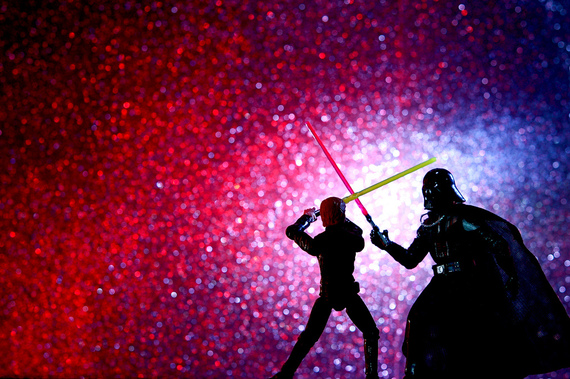By Sean Hutchinson.
Disney figures to bank so much money on Star Wars merchandise this year -- maybe $5 billion in sales in the first year -- that the company has gone so far as to brand the very day it shows us those toys. "Force Friday" is upon us, when, in the words of the Mouse, "new Star Wars themed merchandise and more will land in our galaxy." This is to action figures what the Dec. 18 opening of Star Wars: The Force Awakens is to actual, uh, Star Wars movies.
The "unboxing" of the toys began earlier this week. Crammed under Christmas trees this year will be: a Jedi master lightsaber kit ($50), Chewbacca figurines ($20), a Nerf stormtrooper rifle ($40), tie-in sets from Micro Machines and Lego, and a fat-ass Millennium Falcon that's going to cost parents $120 on the way to blowing their kids' minds.
Star Wars is nothing if not a merchandising empire. George Lucas' greatest vision, arguably, was to guess the extent to which that would be true. On the original 1977 Star Wars, as the Hollywood Reporter has told it, "Fox let Lucas pass up an additional $500,000 directing fee in return for keeping licensing and merchandising rights for himself -- a decision that would cost the studio billions." In the first 35 years after that film, the six Star Wars movies generated some $20 billion in merchandise sales, more than quadruple what the movies made at the box office. The movies, often lambasted as toy commercials, are very much that -- nakedly, in fact. But they happen to be outstanding toy commercials, supplying depth and mythology to things kids absolutely love to play with. There's a nobility in that. Children are going to use these toys to launch infinite hours of imagination and storytelling. People have paid billions for cast-plastic figurines and Lego sets and the rest because they're totally worth it.
The kids who will soon be improvising scripts for their Kylo Ren and Supreme Leader Snoke figurines in minivan backseats and in sandboxes will be enjoying a joyous creativity that Lucas has long since ditched. As producer and Lucas confidant Gary Kurtz put it to the L.A. Times in 2010, toys controlled Lucasfilm. "It's a shame," he told the paper. "They make three times as much on toys as they do on films. It's natural to make decisions that protect the toy business, but that's not the best thing for making quality films." No stranger to profligate merchandising, Disney paid more than $4 billion for Lucasfilm in 2012 largely to get at the franchising tie-ins, the theme park rights, and the stocking-stuffers.
Toy sales kept Han Solo from getting killed off in Return of the Jedi; to quote Harrison Ford, "George didn't think there was any future in dead Han toys." And toy sales no doubt led Lucas to set the decisive battle in that movie on Endor, a planet run by sentient teddy bears. Critics were ready for him when the prequels -- great toy commercials, garbled cinema -- started rolling out. In his 1999 review, Hollywood Reporter critic Frank Scheck said The Phantom Menace "seems designed more as a promotion for Lucasfilm's billion-dollar merchandising concerns than a meaningful chapter in the Star Wars canon."
Lucas probably didn't set out to make three hot-garbage kids' movies, but don't blame toy sales for that. The kids-at-play mentality is the very purpose of having Star Wars in the first place. When they take on the voice and the direction of children, even frickin' Jar-Jar Binks action figures become creatively redeemed. Star Wars toys give kids a tangible expressive outlet, a vivid way to take on new identities, and create their own stories.
Writers who grouse about the flood of Force Awakens toys, like Forbes' Scott Mendelson, warn that "perhaps Disney should remember that they can sell a lot more Star Wars merchandise off of a good Star Wars movie than a bad one." While that's true, it's also easier to make reliably awesome toys than it is to make a magical movie. And which will bring children more hours of joy, in all? I remember hours of entertainment at my disposal with my prequel trilogy Naboo fighter in one hand and my original trilogy X-Wing and Millennium Falcon balancing in the other. It didn't matter that 20 years should have separated their storylines. They were my very own impossible Rogue Squadron, emphasis on my own.
A fellow Star Wars fanatic friend who remains a toy collector to this day, explained that the appeal of the toys is their endless customization. "It's a perfect way to get a roster going with all your favorite characters, and utilizing them in stories that you've only fantasized about," he told me. "And now these fantasies are becoming a reality because of you." He elaborated: "Now you were able to change any little detail about the story you wanted. You could give Boba Fett more screen time or you could make Luke and Vader rule the galaxy as father and son. The Star Wars universe was quite literally in your hands."
To get a more serious angle, I asked writer and toy historian Mark Bellomo, who literally wrote the book on Star Wars toys. "The more a developing child participates in playing with an object, the more they utilize executive functions (and self-regulation skills) -- an umbrella term that behaviorists and child psychologists use for a person's management of their cognitive processes," he explained in an email. "Like deductive and inductive reasoning. Problem-solving. Planning and execution. Task flexibility. Focusing attention. Remembering instructions. Setting and achieving goals." On Star Wars toys in specific, he said: "Star Wars action figures encourage creative play ... which directly influences a kid's social and emotional development. Through manipulating action figures, they recreate what they've seen previously, mimicking what they've observed: They then imitate adult roles."
And, be realistic, my fellow adults -- this is still how many of us role. To wit, in what universe does this BB8 toy not look dope as hell?
Or this remote-controled Millennium Falcon?
The kids playing with these are going to be the ones to continue imagining the next hundred years of Star Wars stories. The director of The Force Awakens, J.J. Abrams, grew up a die-hard Star Wars fan, and his "Mystery Box" mentality suggests a type of nostalgia that pushed him into being a filmmaker. The same goes for Rian Johnson, who's directing Episode VIII, due out in 2017. He discussed his boyhood affinity for Star Wars toys in a podcast interview with fellow filmmaker Terry Gilliam. "I grew up, not just watching those movies but playing with those toys, so as a little kid the first movies I was making in my head were set in that world," Johnson said. "So a big part of it is that sort of direct connection, its almost like an automatic jacking-in into childhood in a weird way I guess."
To hijack a Nietzsche observation, the Star Wars director of the future will be trying to reattain the seriousness he had as a child at play with Star Wars toys. This is the feature of the films that adults so often miss: The movies are nothing more than elaborate prompts, ultimately, for a galaxy far, far away. There, kids with action figures and Legos and plastic lightsabers write their own scripts, make their own sound effects, devise their own plot twists, build their own sets, scout their own locations, and live their own stories. And maybe something awakens.
Photos via www.flickr.com/photos/jdhancock
Also on HuffPost:



